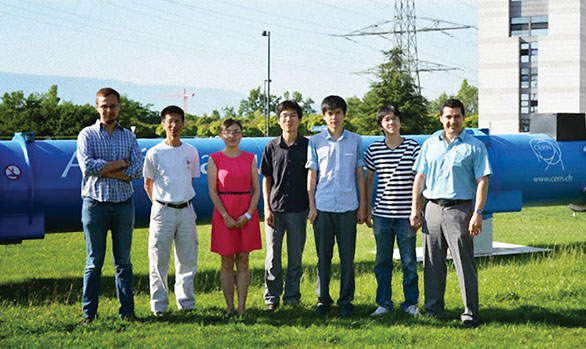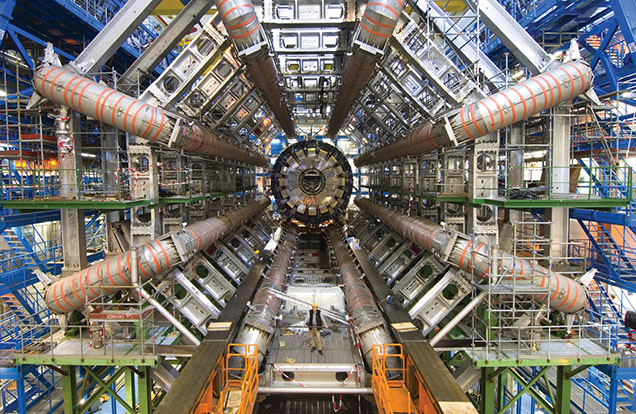Big physics, bigger impact
The development of the Large Hadron Collider provides unique opportunities to answer fundamental questions in particle physics. A team from HKU is playing a role in the Large Hadron Collider’s ATLAS experiment and at the same time aiming to establish a particle physics group in Hong Kong with world-level impact.
The field of high-energy particle physics has been very active over the past century and the launch in 2010 of the Large Hadron Collider (LHC) – the world’s largest and most powerful particle collider and the most complex experimental facility ever built – has only heightened the possibilities for discovery in this field.
More than 10,000 scientists and engineers from over 100 countries are working on the LHC and a group from HKU, collaborating with scientists from the Chinese University of Hong Kong (CUHK) and the Hong Kong University of Science and Technology (HKUST), is playing an important role in the ATLAS Experiment.
Said Dr Yanjun Tu, Assistant Professor in the Department of Physics: “The three teams have been working together since 2014, right after we formed Joint Consortium of Fundamental Physics, marking the first time in the Hong Kong history that all three universities have formed such a joint body for research. The consortium’s aim is to collaborate in establishing a research programme in Astrophysics, Cosmology and Particle Physics in Hong Kong, and to develop working relationships among the member institutions.
“High-energy particle physics is a new research field in Hong Kong, although it has long been a worldwide frontier in physics, addressing the most fundamental questions in the universe. Experimental high-energy particle physics is big science which takes big cooperation, and has a big impact.”
The LHC programme involves hundreds of universities and laboratories, attracting many of the best minds and talents from all over the world. In its first years of operation, perhaps the most famous discovery at the LHC was the Higgs particle, a key element to understanding the mass origin of fundamental particles in the universe. Its discovery, about half a century after its existence was predicted by theorists, marked a triumph in particle physics and science.
Now, after two years of maintenance and upgrade, the LHC came back into operation in April this year and the ATLAS and CMS –Compact Muon Solenoid – experiments are the big ongoing projects. “ATLAS stands for A Toroidal LHC ApparatuS,” said Dr Tu. “It is one of the two general-purpose particle detectors at the LHC. More than 3,000 scientists from 175 institutes in 38 countries work on the experiment, in which the collision information collected by the ATLAS detector is reconstructed and analysed. The scientific goals of the ATLAS and CMS experiments are the same, which is to search for physics beyond the Standard Model, but they have a different technical design.”

The Large Hadron Collider is located in a tunnel about 100m underground, show as a ring of 27km perimeter near Lake Geneva (in the background). The locations of the two large general purpose detectors ATLAS and CMS are also shown (not to scale).

![]() High-energy particle physics is a new research field in Hong Kong, although it has long been a worldwide frontier in physics, addressing the most fundamental questions in the universe. Experimental high-energy particle physics is big science which takes big cooperation, and has a big impact.
High-energy particle physics is a new research field in Hong Kong, although it has long been a worldwide frontier in physics, addressing the most fundamental questions in the universe. Experimental high-energy particle physics is big science which takes big cooperation, and has a big impact. ![]()
Dr Yanjun Tu
Breakthrough in the field
The Hong Kong team joined the ATLAS experiment in June 2014. Since then, the group has been involved in both physics analysis and detector upgrade work. “We focus on searching for supersymmetry particles at the ATLAS experiment,” said Dr Tu. “Any discoveries in these topics will be a breakthrough of the field.
“We are also working with our HKUST and CUHK colleagues on Higgs and exotic physics, and the HKU group has also built up a collaboration with the University of Michigan on preparing the Phase I detector upgrade.”
Further, the team is constructing a Tier-2 computing centre, which will not only serve the local research group, but also the whole ATLAS community. This will also help to make the team more visible in such a big science community.
Dr Tu emphasised that the impact the LHC has had on physics research cannot be under-estimated, and nor can the opportunities it brings for the Hong Kong team.
Six postgraduate students and five undergraduates from the Hong Kong team worked at CERN (Conseil Européen pour la Recherche Nucléaire, or European Council for Nuclear Research) during the summer. Two postdocs are based at CERN long term. Dr Tu predicts that this opportunity is likely to result in some of these students become driving forces to push the development of not only the science but also the technology beyond the present limits.
“In addition, the technology developed for the study of experimental particle physics may have deep and long-term impacts for the whole of human society. A famous example in history is the application of the World Wide Web (WWW), which was firstly created to meet the demand for information-sharing among particle physicists at CERN laboratory and later distributed freely to the world in the early of 1990s.”
It follows then that developing such a new field at HKU is not only helpful for fundamental science, but also for other related research fields. “A good example from the Hong Kong team is that we are collaborating with Professor Ki Wing-hung from the Electronic and Computer Engineering Department at the HKUST on the electronics project for detector upgrade.”
- Promoting unification of current and future independent scientific projects
- Prioritising future research based on an agreed scientific plan
- Fostering a collaborative research environment that will bring various disciplines and institutions together
- Communicating the best available information to the decision-makers and funding sources in Hong Kong in a unified manner
Prime objectives of the Joint Consortium for Fundamental Physics:

Dr Yanjun Tu (third from left) with colleagues and students from The Chinese University of Hong Kong (CUHK) and Hong Kong University of Science and Technology (HKUST).



